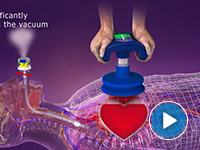IPR Therapy
How IPR therapy works
When patients experience shock or, in extreme cases, cardiac arrest, they require enhanced blood flow to provide sufficient oxygen to vital organs. One way to improve outcomes in states of low blood flow is to enhance negative pressure in the chest by using intrathoracic pressure regulation (IPR), an innovative therapy that leverages the body’s own physiology to improve cardiac output and blood flow to the brain.
Making the Most of Positives and Negatives
The human body is continually regulating circulation of blood by using positive and negative pressures inside the chest. This regulation acts like a bellows. When we inhale, a negative pressure (or vacuum) is created in the chest. This vacuum pulls air into the lungs and blood into the heart, and also slightly lowers pressure in the brain. When we exhale, a positive pressure is created in the chest. This positive pressure forces air out of the lungs, diminishes blood return to the heart, and slightly raises pressure in the brain.1
By enhancing negative pressure in the chest, IPR therapy provides patients in states of low blood flow with better perfusion to the brain and vital organs leading to better outcomes.2 IPR therapy is currently delivered through the following devices: ResQPOD® ITD, ResQGARD® ITD, and the ResQCPR™ System.
1Moreno AH, et al. Am J Physiol. 1967;213(2):455-465.
2Studies available upon request. The generally cleared indication for use of the ResQPOD ITD 10 available for sale in the United States (U.S.) is for a temporary increase in blood circulation during emergency care, hospital, clinic, and home use. The studies referenced here are not intended to imply specific outcomes-based claims not cleared by the U.S. FDA.




